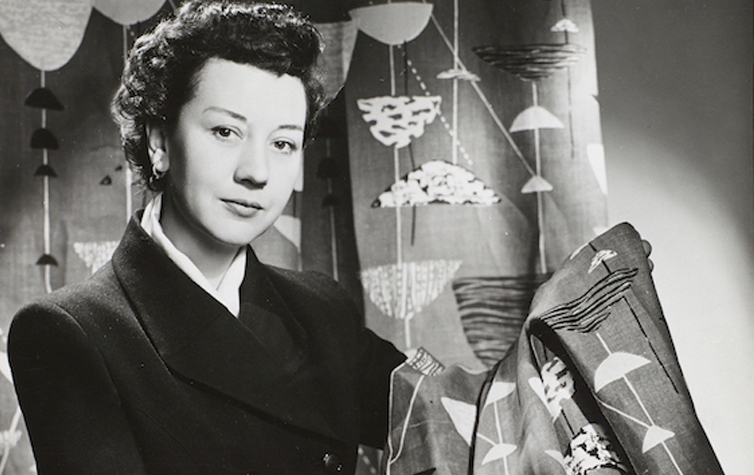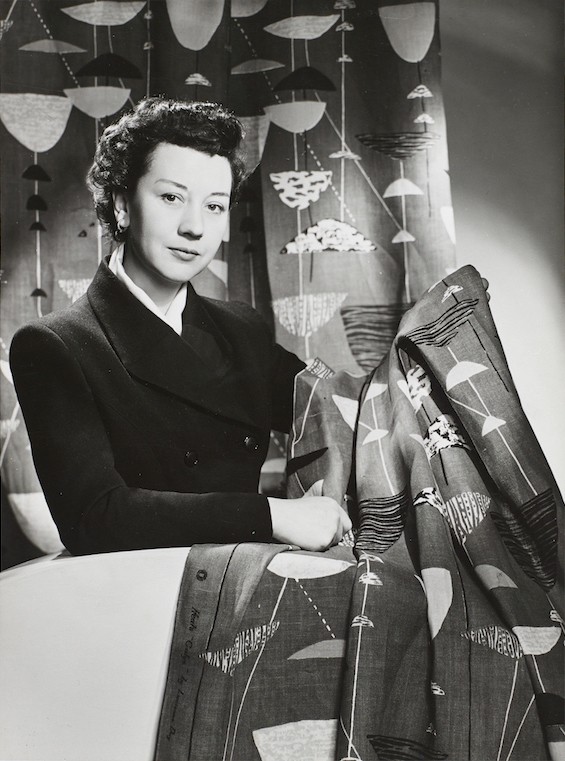
We talk a lot about furniture designers and architects here at Atomic Ranch, but there are many other types of design that create that iconic MCM look. Textile is one such item, and there’s no better way to celebrate National Women’s Month than to highlight the life and designs of Lucienne Day (1917–2010).
Bold Beginnings
Lucienne was a British textile designer who discovered her love of fabric at the age of 17, when she attended Croydon School of Art. She studied textiles at the Royal College of Art, where she met her husband, Robin Day. He was also interested in modernist design as a furniture designer, and the two were married in 1942. Their first home, a flat in London, displayed their early collaborations—his handmade furniture, and her handprinted fabrics.
WWII was in progress, which kept Lucienne from pursuing textile design for a few years, but as soon as the war was over, she became a freelance textile designer, mostly for dress fabrics. However, interior design was her passion, and as soon as she saw the opportunity to switch, she jumped on it.
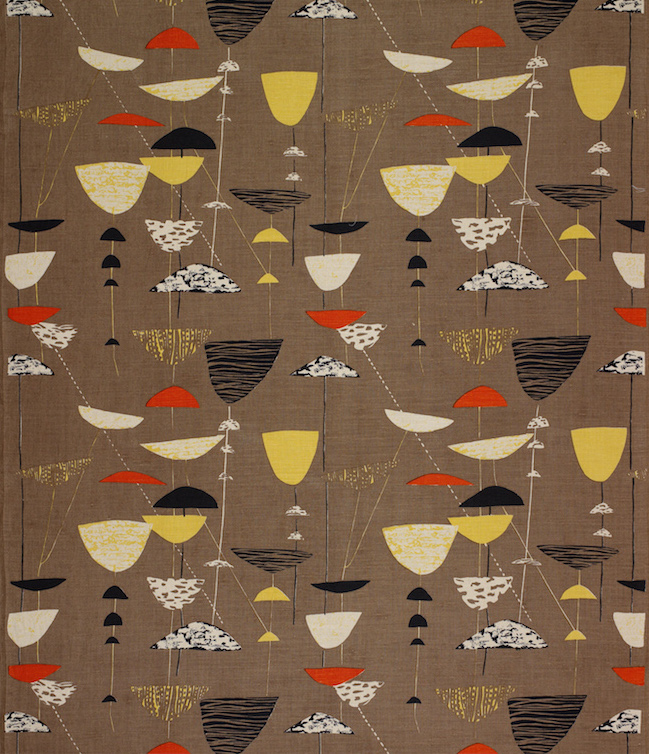
Her career took off at the 1951 Festival of Britain, where she displayed several of her designs—both fabrics and wallpapers—including the most famous design of her career, Calyx. Printed on linen with abstract patterns in yellow, orange-red and olive, it was reminiscent of modernist artwork. The design went on to win several awards, including the Gold Medal at the Milan Triennale and the International Design Award of the American Institute of Decorators.

Stalwart Success
While at the Festival of Britain, Heal Fabrics, a subsidiary of the London department store Heal & Son, saw the fabric and purchased it. The design was so successful that the company commissioned Lucienne to design six new fabrics each year, which she continued to do for the next 25 years. She produced over 70 fabrics for Heal, but also worked with other manufacturers such as Liberty’s and Edinburgh Weavers.
While Lucienne is most famous for her fabrics, she wasn’t afraid to branch out. She also designed wallpaper, ceramics and carpets. In fact, her very first carpet design, Tesserae, won a Design Centre Award. Lucienne occasionally worked with her husband as a design consultant as well, and even helped design the interiors for several aircraft, including the VC10 and Super VC10.
At the time, it was rare for a designer to work internationally, mainly due to the post-war tensions between countries. However, Lucienne managed to be successful in this area as well, and worked with German companies to distribute wallpapers and ceramics.
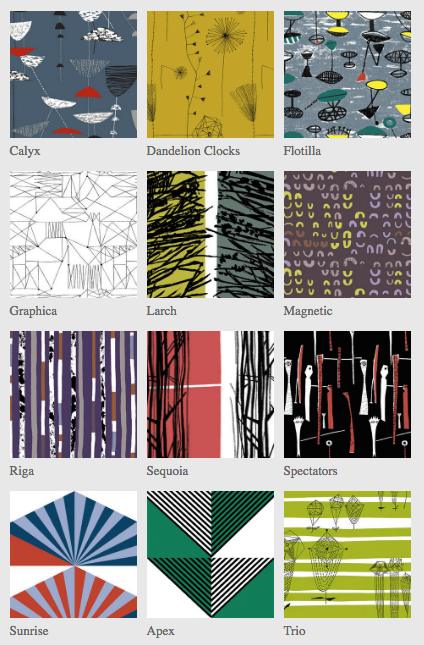
Design Details
During her heyday of the 1950s and ’60s, Lucienne’s designs evolved with the changing design trends. The early 1950s saw energetic designs with doodle-like graphics and motifs with spindly leaves and stems. Some of her more famous designs from that time are Dandelion Clocks (1953) and Graphica (1953).
By the late ’50s, her designs became more painterly, with larger scales. Designs from this period include Sequoia (1959) and Larch (1961).
Of her early designs, Lucienne once remarked: “In the very few years since the end of the war, a new style of furnishing fabrics has emerged…I suppose the most noticeable thing about it has been the reduction in popularity of patterns based on floral motifs and the replacement of these by non-representational patterns—generally executed in clear bright colors, and inspired by the modern abstract school of painting.”
By the 1960s, flower power was trendy, and Lucienne incorporated brighter colors and florals into her fabrics. A few of these include High Noon (1965), Poinsettia (1966) and Causeway (1968).
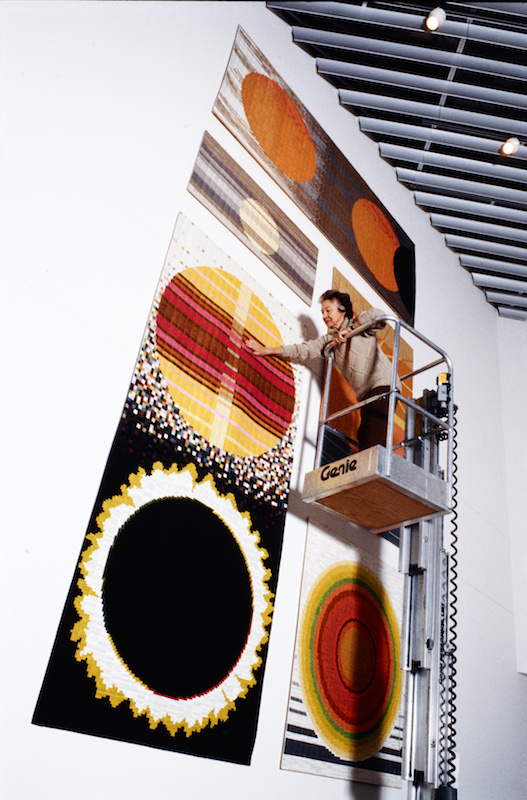
Winding Down
By 1975, many of Lucienne’s close contacts had retired, so she withdrew from mass-produced design. Instead, she created silk mosaic wall hangings, which were exhibited at museums and theaters in the 1980s and ’90s.
But her fabric legacy has continued. Shortly before her death, Lucienne selected 12 of her designs (above collage image) to be reproduced through Classic Textiles, which you can now order on a cotton or linen fabric. That way, you can help Lucienne’s legacy continue to live on in modernist homes.
Atomic Ranch is Celebrating Women’s History Month!
March is Women’s History Month, and to celebrate, join us as we showcase some of the midcentury’s most beloved women designers as well as some modern makers inspired by their legacy. Click here to read more about the ladies behind your favorite designs, pieces and places.

